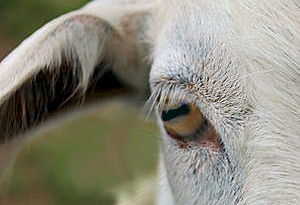 | | A Happy Goat |
The goat is one of the 12 Chinese zodiac animals. It represents introversion, creativity, shyness and being a perfectionist. Goats were one of the first animals to be domesticated and have been used for their milk, meat, hair, and skins all over the world. There are over 100 distinct breeds of goat and there are more than 924 million live goats in the world.
Female goats are referred to as "does" or "nannies", intact males as "bucks" or "billies", and their offspring are "kids". Castrated males are "wethers". Goat meat from younger animals is called "kid" or cabrito (Spanish), and from older animals is simply known as "goat" or sometimes called chevon (French), or in some areas "mutton" (which more often refers to adult sheep meat).
Goats are social animals, however they are not flock-orientated. Goats communicate with each other by bleating. Mothers will often call to their kids to ensure they stay close-by. Mother and kid goats recognize each other's calls soon after birth. Kids can follow their mothers almost immediately after being born. They are very close to their mothers and are weaned after around six months.
Goats are very intelligent and curious animals. Their inquisitive nature is shown by their constant desire to explore and investigate anything unfamiliar.
Goats are considered small livestock animals, compared to bigger animals such as cattle, camels and horses, but larger than microlivestock such as poultry, rabbits, cavies, and bees. Each recognized breed of goats has specific weight ranges, which vary from over 300 lbs for bucks of larger breeds such as the Boer, to 45 to 60 lbs for smaller goat does. Within each breed, different strains or bloodlines may have different recognized sizes. At the bottom of the size range are miniature breeds such as the African Pigmy, which stand 16 to 23 inches at the shoulder as adults.
| | Goats have excellent coordination. They have great balance and are thus able to survive in precarious areas such as steep mountains. They can even climb trees and some species can jump over 5 feet high! |
Most goats naturally have two horns, of various shapes and sizes depending on the breed. Goats have horns unless they are "polled" (meaning, genetically hornless) or the horns have been removed, typically soon after birth.]There have been incidents of polycerate goats (having as many as eight horns), although this is a genetic rarity thought to be inherited. The horns are most typically removed in commercial dairy goat herds, to reduce the injuries to humans and other goats. Unlike cattle, goats have not been successfully bred to be reliably polled, as the genes determining sex and those determining horns are closely linked. Breeding together two genetically polled goats results in a high number of intersex individuals among the offspring, which are typically sterile. Their horns are made of living bone surrounded by keratin and other proteins, and are used for defense, dominance, and territoriality.
Goats are ruminants. They have a four-chambered stomach consisting of the rumen, the reticulum, the omasum, and the abomasum. As with other mammal ruminants, they are even-toed ungulates. The females have an udder consisting of two teats, in contrast to cattle, which have four teats.
 | | Goats have amazing eyes! |
A goat’s eye is rectangular rather than round. They have excellent night vision and will often browse during the night.
Goats have horizontal, slit-shaped pupils. Because goats' irises are usually pale, their contrasting pupils are much more noticeable than in animals such as cattle, deer, most horses and many sheep, whose similarly horizontal pupils blend into a dark iris and sclera. This adaptation allows goats to see at least 320 degrees around their heads with no blind spot in front of them.
Both male and female goats have beards, and many types of goat (most commonly dairy goats, dairy-cross Boers, and pygmy goats) may have wattles, one dangling from each side of the neck.
Some breeds of sheep and goats look similar, but they can usually be told apart because goat tails are short and usually point up, whereas sheep tails hang down and are usually longer and bigger – though some (like those of Northern European short-tailed sheep) are short, and longer ones are often docked.
And best of all according to legend goats discovered coffee! Supposedly an Ethiopian goat herder saw goats behaving more actively and energetically after eating from a particular bush. He then tried it himself and discovered coffee.
Goats are versatile and fascinating animals and make great livestock and are recommended for every farm.
Goat Colors
Goats come in the following colors:
- Black
- Brown
- Fawn
- Red
- White
|
|
